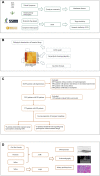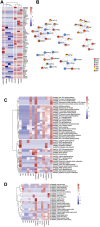Effect of botanical drugs in improving symptoms of hypertensive nephropathy: Analysis of real-world data, retrospective cohort, network, and experimental assessment
- PMID: 37089916
- PMCID: PMC10113664
- DOI: 10.3389/fphar.2023.1126972
Effect of botanical drugs in improving symptoms of hypertensive nephropathy: Analysis of real-world data, retrospective cohort, network, and experimental assessment
Abstract
Background/aim: Hypertensive nephropathy (HN) is a common complication of hypertension. Traditional Chinese medicine has long been used in the clinical treatment of Hypertensive nephropathy. However, botanical drug prescriptions have not been summarized. The purpose of this study is to develop a prescription for improving hypertensive nephropathy, explore the evidence related to clinical application of the prescription, and verify its molecular mechanism of action. Methods: In this study, based on the electronic medical record data on Hypertensive nephropathy, the core botanical drugs and patients' symptoms were mined using the hierarchical network extraction and fast unfolding algorithm, and the protein interaction network between botanical drugs and Hypertensive nephropathy was established. The K-nearest neighbors (KNN) model was used to analyze the clinical and biological characteristics of botanical drug compounds to determine the effective compounds. Hierarchical clustering was used to screen for effective botanical drugs. The clinical efficacy of botanical drugs was verified by a retrospective cohort. Animal experiments were performed at the target and pathway levels to analyze the mechanism. Results: A total of 14 botanical drugs and five symptom communities were obtained from real-world clinical data. In total, 76 effective compounds were obtained using the K-nearest neighbors model, and seven botanical drugs were identified as Gao Shen Formula by hierarchical clustering. Compared with the classical model, the Area under the curve (AUC) value of the K-nearest neighbors model was the best; retrospective cohort verification showed that Gao Shen Formula reduced serum creatinine levels and Chronic kidney disease (CKD) stage [OR = 2.561, 95% CI (1.025-6.406), p < 0.05]. With respect to target and pathway enrichment, Gao Shen Formula acts on inflammatory factors such as TNF-α, IL-1β, and IL-6 and regulates the NF-κB signaling pathway and downstream glucose and lipid metabolic pathways. Conclusion: In the retrospective cohort, we observed that the clinical application of Gao Shen Formula alleviates the decrease in renal function in patients with hypertensive nephropathy. It is speculated that Gao Shen Formula acts by reducing inflammatory reactions, inhibiting renal damage caused by excessive activation of the renin-angiotensin-aldosterone system, and regulating energy metabolism.
Keywords: NF-κB signal pathway; clinical decision support; hypertensive nephropathy; machine learning; real-world data.
Copyright © 2023 Huan, Ma, Li, Hu, Chen, Wang, Su, Su and Wang.
Conflict of interest statement
The authors declare that the research was conducted in the absence of any commercial or financial relationships that could be construed as a potential conflict of interest.
Figures





Similar articles
-
Summarizing the Effective Herbs for the Treatment of Hypertensive Nephropathy by Complex Network and Machine Learning.Evid Based Complement Alternat Med. 2021 Jun 11;2021:5590743. doi: 10.1155/2021/5590743. eCollection 2021. Evid Based Complement Alternat Med. 2021. PMID: 34194519 Free PMC article.
-
MiR-101a ameliorates AngII-mediated hypertensive nephropathy by blockade of TGFβ/Smad3 and NF-κB signalling in a mouse model of hypertension.Clin Exp Pharmacol Physiol. 2019 Mar;46(3):246-254. doi: 10.1111/1440-1681.13042. Epub 2018 Nov 12. Clin Exp Pharmacol Physiol. 2019. PMID: 30304543
-
[Clinical comprehensive evaluation of Huangkui Capsules in treatment of chronic kidney diseases].Zhongguo Zhong Yao Za Zhi. 2022 Mar;47(6):1484-1492. doi: 10.19540/j.cnki.cjcmm.20211124.501. Zhongguo Zhong Yao Za Zhi. 2022. PMID: 35347947 Review. Chinese.
-
JYYS Granule Mitigates Renal Injury in Clinic and in Spontaneously Hypertensive Rats by Inhibiting NF-κB Signaling-Mediated Microinflammation.Evid Based Complement Alternat Med. 2018 Nov 26;2018:8472963. doi: 10.1155/2018/8472963. eCollection 2018. Evid Based Complement Alternat Med. 2018. PMID: 30598687 Free PMC article.
-
Combined therapy of hypertensive nephropathy with ginkgo leaf extract and dipyridamole injection and antihypertensive drugs: A systematic review and meta-analysis.Medicine (Baltimore). 2021 May 14;100(19):e25852. doi: 10.1097/MD.0000000000025852. Medicine (Baltimore). 2021. PMID: 34106629 Free PMC article.
Cited by
-
Targeting lipid reprogramming in the tumor microenvironment by traditional Chinese medicines as a potential cancer treatment.Heliyon. 2024 May 7;10(9):e30807. doi: 10.1016/j.heliyon.2024.e30807. eCollection 2024 May 15. Heliyon. 2024. PMID: 38765144 Free PMC article. Review.
-
JiangyaTongluo decoction ameliorates tubulointerstitial fibrosis via regulating the SIRT1/PGC-1α/mitophagy axis in hypertensive nephropathy.Front Pharmacol. 2024 Dec 12;15:1491315. doi: 10.3389/fphar.2024.1491315. eCollection 2024. Front Pharmacol. 2024. PMID: 39726785 Free PMC article.
-
Advance on Chinese Medicine for Hypertensive Renal Damage: Focus on the Complex Molecular Mechanisms.Chin J Integr Med. 2024 Oct;30(10):938-948. doi: 10.1007/s11655-024-3662-3. Epub 2024 Jul 3. Chin J Integr Med. 2024. PMID: 38958884 Review.
References
-
- Bakris G. L., Sarafidis P. A., Weir M. R., Dahlof B., Pitt B., Jamerson K., et al. (2010). Renal outcomes with different fixed-dose combination therapies in patients with hypertension at high risk for cardiovascular events (ACCOMPLISH): A prespecified secondary analysis of a randomised controlled trial. Lancet 375 (9721), 1173–1181. 10.1016/S0140-6736(09)62100-0 - DOI - PubMed
LinkOut - more resources
Full Text Sources

